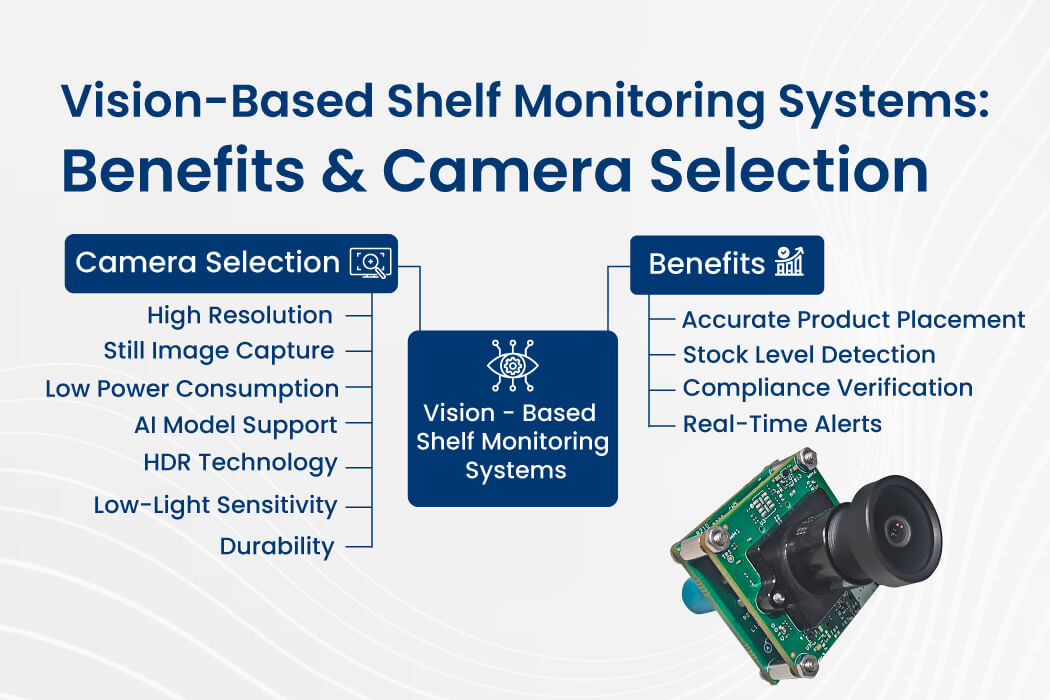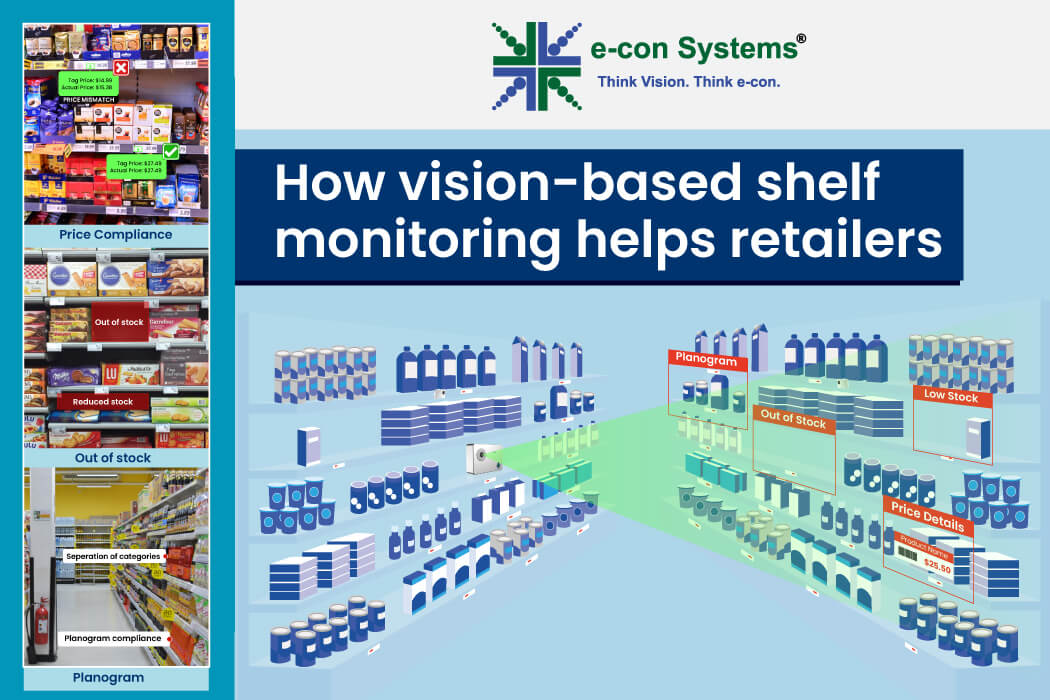Shelf monitoring systems automate the tracking of inventory on shelves in modern retail settings. These systems play a major role in maintaining stock levels, driving product availability, and verifying that promotions and pricing are correctly displayed.
Hence, it helps in reducing discrepancies regarding inventory while elevating the overall shopping experience for customers.
Let’s find out more about vision-based shelf monitoring systems, their benefits, and how to choose the right camera features.
How Cameras Are Used In Shelf Monitoring Systems
High-performance cameras play a critical role in leveraging planograms, which are the backbone of shelf monitoring. They provide a detailed visual representation of the optimal product layout on retail shelves. It drives consistent product placement, helping retailers monitor stock levels, ensure product visibility, and verify compliance with merchandising standards. This allows for easier identification of out-of-stock items, misplaced products, and promotional display issues.
- Image capture: Cameras are strategically placed to continuously capture high-resolution images of retail shelves. They cover extensive views to identify products, price tags, and promotional materials.
- Data transmission: Images are transmitted in real time or at scheduled intervals to a central processing system via wired or wireless networks.
- Image processing: The images undergo processing to extract information such as product labels, price tags, and shelf spaces using OCR and object recognition.
- Planogram creation: Processed data is used to generate planograms. Specialized software creates visual representations of the store layout, ensuring optimal product placement.
- Data analysis: Planograms are analyzed to assess factors like stock levels, product placement compliance, and promotional display visibility. AI models are then used to detect in-stocks, out-of-stocks, lows, and planogram non-compliance, providing real-time insights.
- Actionable insights: Insights are compiled into reports or dashboards for retail managers. Shelf-monitoring systems can generate alerts for immediate issues like restocking shelves or adjusting product placements. Planograms can also be adapted to real-time shelf conditions for more improved sales.
Benefits of Vision-Based Shelf Monitoring Systems
- Vision-based systems ensure products are always placed correctly according to planograms, enhancing organization and customer experience.
- High-resolution cameras and AI detect stock levels, identifying out-of-stock items and low inventory, enabling prompt restocking.
- Continuous image capture and processing verify compliance with merchandising standards while ensuring promotional displays and product placements are accurate.
- These systems generate detailed reports and real-time alerts for retail managers, facilitating quick responses to shelf issues and improving overall store performance.

Selecting the Right Camera for Shelf Monitoring Systems
High resolution (4K to 20MP)
For seamless shelf monitoring, cameras need high resolution, ranging from 4K to 20MP. Such a high level of detail ensures accurate identification of individual products, price tags, and promotional materials. Even small text and finer details can be captured accurately for better analysis and compliance verification. High-resolution images also support advanced image processing algorithms, enhancing the accuracy of stock level assessments and promotional compliance checks.
Still capture
The ability to capture still images goes a long way to maintaining a detailed record of shelf conditions at specific moments. It helps create accurate planograms, audit product placements, and verify stock levels without the motion blur that can occur in video capture. Still images are also important for generating high-quality insights, providing a reliable basis for long-term trend analysis and historical data comparison.
Low power consumption
Low power consumption is a key camera feature in vision-based shelf monitoring systems. It makes sure they can operate continuously without major energy costs. It also makes these systems more practical for large-scale deployments while ensuring longer operational periods and reduced downtime for maintenance. Additionally, low power cameras contribute to the overall environmental sustainability of retail operations by minimizing energy usage and carbon footprints.
Running various AI models
Modern shelf monitoring systems benefit from cameras capable of supporting various AI models, such as object detection and facial recognition. Such AI capabilities are needed for analyzing complex shelf environments where accurate identification of products and customer interaction patterns are required. Cameras with built-in AI processing capabilities can perform these tasks at the edge, reducing latency and lowering bandwidth requirements by transmitting only relevant data.
Also, the ability of these cameras to run advanced AI models directly on the device enhances the real-time processing of visual data. It can be used for triggering instant alerts and actions based on the analysis. For instance, if a camera detects that a product is out of stock, it can immediately alert store personnel to replenish the shelf.
HDR (High Dynamic Range)
High Dynamic Range (HDR) enables the camera to capture images that accurately represent both very bright and very dark areas. It ensures clear visibility of products under diverse lighting conditions. This can be extremely useful for running AI algorithms, as it improves the accuracy of object recognition and other analyses.
Moreover, HDR technology adapts to sudden changes in lighting, such as the transition from natural daylight to artificial lighting, which is common in retail environments. It prevents underexposed or overexposed images so that all visual data collected is of high quality and usable for detailed analysis. By maintaining consistent image clarity across various lighting scenarios, HDR-equipped cameras can more reliably track inventory changes and customer interactions.
Superior low-light and NIR sensitivity
Cameras with superior low-light performance and near-infrared (NIR) sensitivity enable consistent operation across different times of day and lighting scenarios. These features ensure that the cameras can capture high-quality images in low-light conditions, such as early mornings or late evenings and even in back areas of stores where lighting might not be optimal.
IP67-rated enclosure
Cameras with an IP67 rating are protected against dust and water, making them suitable for various environmental conditions found in retail settings, including outdoor areas or refrigerated sections. Such durability also ensures that cameras can operate reliably without frequent maintenance despite exposure to elements that might otherwise compromise the system’s functionality
The Right Interface for Vision-Based Shelf Monitoring Systems
GMSL interface
A GMSL interface paired with an NVIDIA processing platform provides a high-bandwidth, low-latency solution ideal for real-time shelf-monitoring systems. It enables the transmission of high-resolution video over long distances using a single coaxial cable, which also powers the camera. GMSL also supports high frame rates and synchronized multi-camera setups, which are critical for accurate shelf monitoring across large store areas.
Moreover, in retail environments, multiple camera streams must be processed with minimal delay. Hence, it is important to leverage NVIDIA’s processing capabilities at the edge so that the image data from GMSL cameras can be analyzed in real time. It results in faster response to shelf events and inventory changes. So, NVIDIA platform integration makes sure that AI-based analytics can run close to the data source.
Wi-Fi capability
Wi-Fi capability in vision-based shelf monitoring systems enables wireless data transmission, which eliminates the need for complex cabling. It also makes it easier to install and maintain these systems while helping real-time monitoring and quick data transfer to central processing systems.
Additionally, Wi-Fi battery-powered cameras provide the flexibility to relocate cameras based on changes in retail layouts, enhancing the scope of coverage. Shelf monitoring systems can also be easily reconfigured to meet changing store designs and new merchandising strategies.
For instance, e-con Systems offers SHELFVista – an AI-based Wi-Fi camera that ensures continuous shelf visibility by delivering real-time imaging data. That way, retailers can make intelligent decisions to reduce out-of-stock issues, ensure planogram compliance, and detect pricing and labeling discrepancies.
Learn more about e-con Systems’ SHELFVista
e-con Systems’ Cameras for Shelf Monitoring Systems
e-con Systems, with 20+ years of experience in designing, developing, and manufacturing OEM cameras, has kept pace with the rapid changes in the retail industry. As mentioned earlier, SHELFVista is our latest battery-powered Wi-Fi camera that offers a compact imaging solution for monitoring shelves and displays in retail stores. Its features include 13MP (upgradable to 20MP) resolution, multi-rack optics coverage, on-camera AI intelligence, dual-band Wi-Fi (2.4/5 GHz), AI-powered privacy compliance, and more.
We also provide other high-performance shelf-monitoring cameras such as:
- NileCAM130 – 13MP GMSL2 Camera Module with 15m Cable Support
- NileCAM200 – 20MP AR2020 High Resolution GMSL2™ Camera Module
- STURDeCAM88 – 4K 140dB HDR GMSL2 Camera Module
See all our OEM custom cameras
Visit our Camera Selector page to see e-con Systems’ full portfolio
If you want to know about the specifications of our Wi-Fi camera or need help integrating cameras into your retail product, please write to us at camerasolutions@e-consystems.com.

Ranjith is a camera solution architect with over 16 years of experience in embedded product development, electronics design, and product solutioning. In e-con Systems, he has been responsible for building 100+ vision solutions for customers spanning multiple areas within retail including self service kiosks, access control systems, smart checkouts and carts, retail monitoring systems, and much more.




